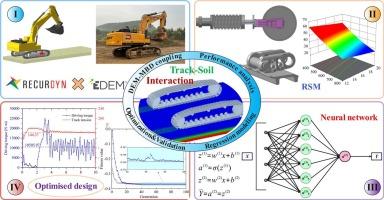基于DEM-MBD耦合法的轨道-土壤相互作用动力特性分析与优化
IF 4.6
2区 工程技术
Q2 ENGINEERING, CHEMICAL
引用次数: 0
摘要
履带式底盘与地形的耦合建模研究对于虚拟物理测绘和智能设计具有重要意义。本文建立了基于离散元法(DEM)和多体动力学(MBD)耦合的轨道-土壤相互作用高精度仿真模型。通过试验验证了模型的可靠性,并对轨道与土体的耦合特性进行了深入研究。在验证模型的基础上,采用响应面法分析了滑轨高度、履带宽度等关键结构参数和链轮转速、预张力等运动参数对底盘性能的影响。为实现履带式底盘性能的智能优化,建立了基于神经网络的非线性代理模型,并采用遗传算法进行多目标优化。优化结果表明,在保持牵引性能的前提下,驱动力矩减小17.38%,土壤沉降减小41.38%,轨道张力增幅控制在14.94%以内。所提出的基于智能算法的优化策略在能耗、地形适应性、系统可靠性等方面显著提高履带式底盘综合性能,为工程机械的智能化设计提供了有价值的见解。本文章由计算机程序翻译,如有差异,请以英文原文为准。

Dynamic characteristics analysis and optimization of track-soil interaction based on DEM-MBD coupling method
The study of coupling modeling between tracked chassis and terrain is of great significance for virtual-physical mapping and intelligent design. This paper establishes a high-precision simulation model for track-soil interaction based on the coupling of discrete element method (DEM) and multi-body dynamics(MBD). The model's reliability was validated through experiments, and the coupling behavior between the track and soil was thoroughly investigated. Based on the validated model, the response surface method was used to reveal the influence of key structural parameters, such as grouser height and track width, and motion parameters, such as sprocket speed and pre-tension force, on the chassis performance. To enable intelligent optimization of tracked chassis performance, a nonlinear surrogate model based on neural networks was developed, and multi-objective optimization was carried out using the genetic algorithm. The optimization results indicate that, while maintaining traction performance, the driving torque was reduced by 17.38 %, soil sinkage was reduced by 41.38 %, and the increase in track tension was controlled within 14.94 %. The proposed optimization strategy based on intelligent algorithms significantly improves the comprehensive performance of the tracked chassis in terms of energy consumption, terrain adaptability, and system reliability, offering valuable insights for the intelligent design of construction machinery.
求助全文
通过发布文献求助,成功后即可免费获取论文全文。
去求助
来源期刊

Powder Technology
工程技术-工程:化工
CiteScore
9.90
自引率
15.40%
发文量
1047
审稿时长
46 days
期刊介绍:
Powder Technology is an International Journal on the Science and Technology of Wet and Dry Particulate Systems. Powder Technology publishes papers on all aspects of the formation of particles and their characterisation and on the study of systems containing particulate solids. No limitation is imposed on the size of the particles, which may range from nanometre scale, as in pigments or aerosols, to that of mined or quarried materials. The following list of topics is not intended to be comprehensive, but rather to indicate typical subjects which fall within the scope of the journal's interests:
Formation and synthesis of particles by precipitation and other methods.
Modification of particles by agglomeration, coating, comminution and attrition.
Characterisation of the size, shape, surface area, pore structure and strength of particles and agglomerates (including the origins and effects of inter particle forces).
Packing, failure, flow and permeability of assemblies of particles.
Particle-particle interactions and suspension rheology.
Handling and processing operations such as slurry flow, fluidization, pneumatic conveying.
Interactions between particles and their environment, including delivery of particulate products to the body.
Applications of particle technology in production of pharmaceuticals, chemicals, foods, pigments, structural, and functional materials and in environmental and energy related matters.
For materials-oriented contributions we are looking for articles revealing the effect of particle/powder characteristics (size, morphology and composition, in that order) on material performance or functionality and, ideally, comparison to any industrial standard.
 求助内容:
求助内容: 应助结果提醒方式:
应助结果提醒方式:


